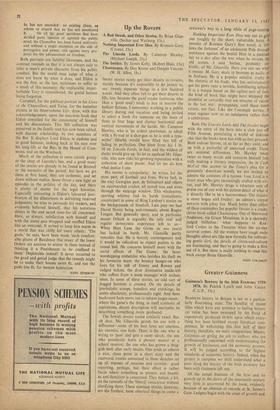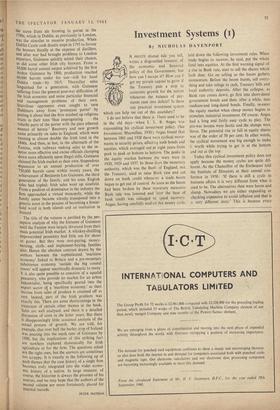Greater Guinness
Guinness's Brewery in the Irish Economy 1759- 1876. By Patrick Lynch and John Vaizey. (C.U.P., 35s.) BUSINESS history in Britain is not in a particu- larly flourishing state. The handful. of recent titles which have any pretence to lasting histori- cal value has been swamped by the flood of expensively produced tit-bits upon which every- thing has been lavished except historical com- petence. In welcoming this first half of their history, therefore, we must congratulate Messrs. Guinness on giving the job to authors who are professionally concerned with understanding the growth of businesses and the economic process. It will be judged according to the highest standards of economic history. Indeed, when the project is complete we shall understand what a poor thing the history of the Irish economy has been with Guinness left out.
Of the actual business of the firm and its growth up to the dawn of the nineteenth century very little is uncovered by the book, evidently because of an absence of records at St. James's Gate. Ledgers begin with the onset of growth and the move from ale brewing to, porter in the 1790s, which in Dublin, as previously in London, was the stimulus to massive production. When Dublin Castle took drastic steps in 1795 to favour the brewers fiscally at the expense of distillers, and after war had brought problems to London exporters, Guinness quickly seized their chance, as did some other Irish city brewers. From a 10,000 barrel annual output achieved by the first Arthur Guinness by 1800, production reached 60,000 barrels under his son—still for local Dublin trade—by 1815. Thereafter sales languished for a generation, with Guinness suffering from the general post-war difficulties of the Irish economy and some particular financial and management problems of their own. Scurrilous opponents even sought to turn Dubliners away from 'protestant porter' by Putting it about that the firm mashed up religious
tracts in their tuns 'thus impregnating . the volatile parts of the porter with the pure ethereal essence of heresy.' Recovery and new growth Came primarily on sales to England, which were running at almost double the Irish total in the 1840s. And then, at last, in the aftermath of the Famine, with railways making sales to the in- terior more effective and excise officials clamping down more efficiently upon illegal stills, Guinness claimed the Irish market as their own. Stupendous expansion to an annual production of over 750,000 barrels came within twenty years, the achievement of Benjamin Lee Guinness, the third generation of the family, and his sons. English sales had tripled: Irish sales went up ninefold. From a position of dominance in the industry the firm approached a virtual monopoly, while the family name became silently transposed into a generic noun in the process of becoming a house- hold word in both islands and an institution in Ireland.
The title of the volume is justified by the per- ceptive analysis of why the fortunes of Guinness until the Famine were largely divorced from their main potential Irish market. A whiskey-distilling impoverished peasantry had little use for shot's or porter. But they were rent-paying, money- earning, cloth- and implement-buying families .also. Hence the absolute contrast drawn by the authors between the sophisticated 'maritime economy' linked to Britain and a pre-monetary .subsistence economy 'outside the big coastal
towns' will appear uncritically dramatic to many. It is also quite possible to conceive of a squalid Peasantry, who provide no market for an urban industrialist, being specifically geared into the export sector of a 'maritime economy,' as their income from sales of produce is creamed off as rent. Indeed, part of the Irish problem was exactly this. There are sonic shortcomings in the treatment of certain other themes in the book. Sales are well analysed, and there is a detailed discussion of costs in the latter years. But there IS disappointingly little sustained analysis of the actual process of growth. We are told, for example, that over half the barley crop of Ireland Was pouring into the mash tuns of Guinness by 1880, but the implications of this striking fact are nowhere explored dynamically for Irish agriculture or for the firm. The questions asked are the right ones, but the answers are sometimes too scrappy. It is exactly in the following up of such themes that the case history of a single firm becomes truly integrated into the wider econo- mic history of a nation. In large measure, of course, the historian is always the prisoner of his sources, and we may hope that the authors of the second volume are more fortunately placed for internal records.
PETER MATHIAS



































 Previous page
Previous page